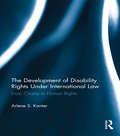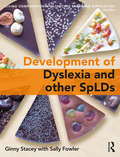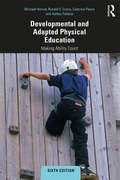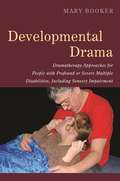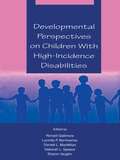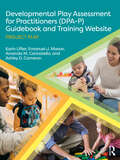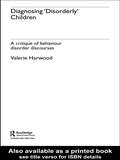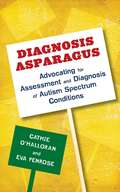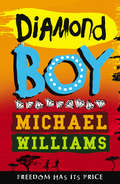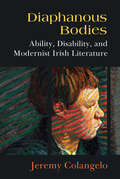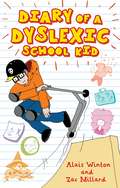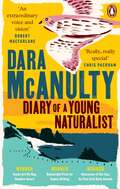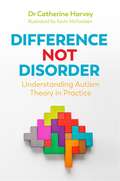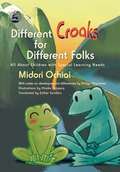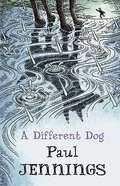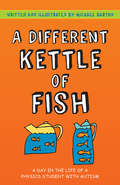- Table View
- List View
The Development of Disability Rights Under International Law: From Charity to Human Rights
by Arlene S. KanterThe adoption of the Convention on the Rights of People with Disabilities (CPRD) by the United Nations in 2006 is the first comprehensive and binding treaty on the rights of people with disabilities. It establishes the right of people with disabilities to equality, dignity, autonomy, full participation, as well as the right to live in the community, and the right to supported decision-making and inclusive education. Prior to the CRPD, international law had provided only limited protections to people with disabilities. This book analyses the development of disability rights as an international human rights movement. Focusing on the United States and countries in Asia, Africa, the Middle East the book examines the status of people with disabilities under international law prior to the adoption of the CPRD, and follows the development of human rights protections through the convention’s drafting process. Arlene Kanter argues that by including both new applications and entirely new approaches to human rights treaty enforcement, the CRPD is significant not only to people with disabilities but also to the general development of international human rights, by offering new human rights protections for all people. Taking a comparative perspective, the book explores how the success of the CRPD in achieving protections depends on the extent to which individual countries enforce domestic laws and policies, and the changing public attitudes towards people with disabilities. This book will be of excellent use and interest to researchers and students of human rights law, discrimination, and disability studies.
The Development of Disability Rights Under International Law: From Charity to Human Rights
by Arlene S. KanterThe adoption of the Convention on the Rights of People with Disabilities (CPRD) by the United Nations in 2006 is the first comprehensive and binding treaty on the rights of people with disabilities. It establishes the right of people with disabilities to equality, dignity, autonomy, full participation, as well as the right to live in the community, and the right to supported decision-making and inclusive education. Prior to the CRPD, international law had provided only limited protections to people with disabilities. This book analyses the development of disability rights as an international human rights movement. Focusing on the United States and countries in Asia, Africa, the Middle East the book examines the status of people with disabilities under international law prior to the adoption of the CPRD, and follows the development of human rights protections through the convention’s drafting process. Arlene Kanter argues that by including both new applications and entirely new approaches to human rights treaty enforcement, the CRPD is significant not only to people with disabilities but also to the general development of international human rights, by offering new human rights protections for all people. Taking a comparative perspective, the book explores how the success of the CRPD in achieving protections depends on the extent to which individual countries enforce domestic laws and policies, and the changing public attitudes towards people with disabilities. This book will be of excellent use and interest to researchers and students of human rights law, discrimination, and disability studies.
The Development of Dyslexia and other SpLDs
by Ginny Stacey Sally FowlerDevelopment of Dyslexia and Other SpLDs is about the persistence of dyslexia and specific learning difficulties (SpLD) into adulthood. It pulls together experiences of many dyslexic/SpLD people. The book is written with non-linear readers in mind: those who need to move about a book picking up ideas that are currently relevant to them; a style that suits many dyslexic/SpLD readers. The book gives a framework for understanding the wide-ranging experiences of dyslexic/SpLD adults. With the greater understanding, there should be better help for: • adults who still have no strategies for dealing with dyslexic/ SpLD problems • children who have some skills but not at the level of their overall intelligence • young children who show the first signs of difficulties • dyslexic/SpLD children in mainstream schools. A new paradigm is proposed whereby all teaching programmes utilise each learner’s learning strengths - catering for dyslexic and SpLD adults and children involves vital teaching and learning approaches that are good practice for all.
Developmental and Adapted Physical Education: Making Ability Count
by Michael Horvat Ronald V. Croce Caterina Pesce Ashley Eason FallaizeNow in a fully revised and updated 6th edition, reflecting changes in legislation and cutting-edge research, this is a complete introduction to adapted physical education, from the underpinning science to practical teaching strategies and program design. The book covers a broader range of disabilities, developmental disorders, and health conditions than any other textbook and includes brand new material on developmental coordination disorders and cognitive development. Full of teaching and coaching strategies and techniques, it introduces scientific fundamentals, key legislation, and best practice in designing effective programs. It encourages the reader to consider the individual before the disability and to focus on what learners can do rather than what they can’t. This is an essential reference for teachers, coaches, or exercise professionals working with children with disabilities. It is also an invaluable resource for undergraduate or postgraduate students of adapted physical education, kinesiology, physical education, physical therapy, exercise science, athletic training, or sports coaching. The new edition features updated online resources, including PowerPoint slides, web links, an example syllabus, and quizzes.
Developmental and Adapted Physical Education: Making Ability Count
by Michael Horvat Ronald V. Croce Caterina Pesce Ashley Eason FallaizeNow in a fully revised and updated 6th edition, reflecting changes in legislation and cutting-edge research, this is a complete introduction to adapted physical education, from the underpinning science to practical teaching strategies and program design. The book covers a broader range of disabilities, developmental disorders, and health conditions than any other textbook and includes brand new material on developmental coordination disorders and cognitive development. Full of teaching and coaching strategies and techniques, it introduces scientific fundamentals, key legislation, and best practice in designing effective programs. It encourages the reader to consider the individual before the disability and to focus on what learners can do rather than what they can’t. This is an essential reference for teachers, coaches, or exercise professionals working with children with disabilities. It is also an invaluable resource for undergraduate or postgraduate students of adapted physical education, kinesiology, physical education, physical therapy, exercise science, athletic training, or sports coaching. The new edition features updated online resources, including PowerPoint slides, web links, an example syllabus, and quizzes.
Developmental And Adapted Physical Education (PDF)
by H. Clarke David ClarkeThis comprehensive book on developmental and adapted physical education is intended for physical educators in schools and colleges, although applications to physical reconditioning and corrective therapy in hospitals and rehabilitation centers can readily be made.
Developmental Drama: Dramatherapy Approaches for People with Profound or Severe Multiple Disabilities, Including Sensory Impairment
by Mary Adelaide BookerPeople living with severe or profound multiple disabilities (PMLD) can often struggle to connect with the world around them. This book shows how, through enjoying dramatic interaction, they can develop their communication skills, learn to deal with emotions more effectively and gain a greater understanding of their physical and social environment. This guide presents a variety of ways in which drama can be used as a medium for assisting the social and emotional development of people with PMLD, including sensory impairment. It fully explains techniques that are proven to build confidence and promote participation, and illustrates how to include support staff effectively within the process. Charting the author's own journey as a dramatherapist, it clarifies in detail some effective approaches and how to address key issues that arise in dramatherapy practice. This is an accessible and life-saving guide for practitioners looking to use drama in work with people with PMLD, but are unsure where to begin.
Developmental Drama: Dramatherapy Approaches for People with Profound or Severe Multiple Disabilities, Including Sensory Impairment (PDF)
by Mary Adelaide BookerPeople living with severe or profound multiple disabilities (PMLD) can often struggle to connect with the world around them. This book shows how, through enjoying dramatic interaction, they can develop their communication skills, learn to deal with emotions more effectively and gain a greater understanding of their physical and social environment. This guide presents a variety of ways in which drama can be used as a medium for assisting the social and emotional development of people with PMLD, including sensory impairment. It fully explains techniques that are proven to build confidence and promote participation, and illustrates how to include support staff effectively within the process. Charting the author's own journey as a dramatherapist, it clarifies in detail some effective approaches and how to address key issues that arise in dramatherapy practice. This is an accessible and life-saving guide for practitioners looking to use drama in work with people with PMLD, but are unsure where to begin.
Developmental Perspectives on Children With High-incidence Disabilities (The LEA Series on Special Education and Disability)
by Ronald Gallimore Lucinda P. Bernheimer Donald L. MacMillan Deborah L. Speece Sharon VaughnThis volume has two purposes. The first is to summarize, substantiate, and extend current knowledge on the development of children with high incidence disabilities--most notably, learning disabilities, behavioral disorders, and mild mental retardation. The second is to honor the career of Professor Barbara K. Keogh and her contributions to the developmental study of children with high incidence disabilities. Internationally recognized for her accomplishments, Keogh is esteemed for her originality and clarity of thought. For nearly forty years, she has set an extraordinary model of analytic rigor combined with a kind and generous manner that inspires, supports, and sets an exacting standard of scholarship. The contributing authors to this volume represent only a fraction of the students and scholars touched by her distinguished career. In conceiving this volume, the editors sought to represent the topics, problems, and issues to which Keogh has devoted herself. They invited chapters that summarize what is known about the high incidence handicapping conditions that her research has mainly addressed and sought to reflect the probing, questioning style that she brings to her own work. Researchers, policymakers, and graduate students in special education and associated disciplines who seek to stay current will find this volume crucial reading.
Developmental Perspectives on Children With High-incidence Disabilities (The LEA Series on Special Education and Disability)
by Ronald Gallimore Lucinda P. Bernheimer Donald L. MacMillan Deborah L. Speece Sharon R. VaughnThis volume has two purposes. The first is to summarize, substantiate, and extend current knowledge on the development of children with high incidence disabilities--most notably, learning disabilities, behavioral disorders, and mild mental retardation. The second is to honor the career of Professor Barbara K. Keogh and her contributions to the developmental study of children with high incidence disabilities. Internationally recognized for her accomplishments, Keogh is esteemed for her originality and clarity of thought. For nearly forty years, she has set an extraordinary model of analytic rigor combined with a kind and generous manner that inspires, supports, and sets an exacting standard of scholarship. The contributing authors to this volume represent only a fraction of the students and scholars touched by her distinguished career. In conceiving this volume, the editors sought to represent the topics, problems, and issues to which Keogh has devoted herself. They invited chapters that summarize what is known about the high incidence handicapping conditions that her research has mainly addressed and sought to reflect the probing, questioning style that she brings to her own work. Researchers, policymakers, and graduate students in special education and associated disciplines who seek to stay current will find this volume crucial reading.
Developmental Play Assessment for Practitioners (DPA-P) Guidebook and Training Website: Project Play
by Karin Lifter Emanuel J. Mason Amanda M. Cannarella Ashley D. CameronDevelopmental Play Assessment for Practitioners (DPA-P) Guidebook and Training Website: Project Play offers a comprehensive assessment of naturally occurring play activities for evaluating young children’s developmental progress accurately, so that useful interventions can take place as early as possible. It can be used by practitioners in a wide range of educational and therapeutic settings and is designed to support developmental progress through planning interventions in play, and using what we know about a child’s progress in play to plan play-based interventions in cognition, language, motor, social-emotional, and self-help skills. The guidebook and training website provide a comprehensive introduction to how to successfully use the assessment with infants, toddlers, and young children with disabilities or at risk for disabilities. The comprehensive guidebook offers an overview of the DPA-P and Project Play, defines play, discusses the background literature on play, and explains why this assessment is needed. Clear guidance helps practitioners and family members understand play, how to evaluate play, and how to use play for different purposes. The guidebook offers: an introduction to the comprehensive training website and how to use it understanding of the categories of play assessed and their definitions guidance on how to administer the assessment and prepare a summary evaluation of a child’s performance clear instructions for the coding sheets and scoring guidelines for constructing sets of toys guidance on taking the results of the DPA-P evaluation of a child’s progress in play to develop a plan of activities for intervention explanation of how you evaluate activities at the absence, basic, emergence, and mastery levels for developing a plan suggestions for assembling sets of toys for intervention, based on toys available in children’s homes and early childhood settings procedures for facilitating or teaching play activities to children who are developing more slowly than their peers technical aspects of the assessment To make the DPA-P as flexible as possible for all practitioners, it also offers guidance on adaptations for administering the test, in the coding sheets, with toys to enhance cultural appropriateness for gathering the observations, and for supporting interventions in play. The Developmental Play Assessment for Practitioners (DPA-P) can be used in natural settings and takes 30 minutes to complete. It is a valuable tool for all those who serve, or are training to serve, young children in early childhood settings, schools, service agencies, colleges, and universities. It will be of great benefit for early intervention personnel, speech-language pathologists, physical therapists, occupational therapists, and psychologists.
Developmental Play Assessment for Practitioners (DPA-P) Guidebook and Training Website: Project Play
by Karin Lifter Emanuel J. Mason Amanda M. Cannarella Ashley D. CameronDevelopmental Play Assessment for Practitioners (DPA-P) Guidebook and Training Website: Project Play offers a comprehensive assessment of naturally occurring play activities for evaluating young children’s developmental progress accurately, so that useful interventions can take place as early as possible. It can be used by practitioners in a wide range of educational and therapeutic settings and is designed to support developmental progress through planning interventions in play, and using what we know about a child’s progress in play to plan play-based interventions in cognition, language, motor, social-emotional, and self-help skills. The guidebook and training website provide a comprehensive introduction to how to successfully use the assessment with infants, toddlers, and young children with disabilities or at risk for disabilities. The comprehensive guidebook offers an overview of the DPA-P and Project Play, defines play, discusses the background literature on play, and explains why this assessment is needed. Clear guidance helps practitioners and family members understand play, how to evaluate play, and how to use play for different purposes. The guidebook offers: an introduction to the comprehensive training website and how to use it understanding of the categories of play assessed and their definitions guidance on how to administer the assessment and prepare a summary evaluation of a child’s performance clear instructions for the coding sheets and scoring guidelines for constructing sets of toys guidance on taking the results of the DPA-P evaluation of a child’s progress in play to develop a plan of activities for intervention explanation of how you evaluate activities at the absence, basic, emergence, and mastery levels for developing a plan suggestions for assembling sets of toys for intervention, based on toys available in children’s homes and early childhood settings procedures for facilitating or teaching play activities to children who are developing more slowly than their peers technical aspects of the assessment To make the DPA-P as flexible as possible for all practitioners, it also offers guidance on adaptations for administering the test, in the coding sheets, with toys to enhance cultural appropriateness for gathering the observations, and for supporting interventions in play. The Developmental Play Assessment for Practitioners (DPA-P) can be used in natural settings and takes 30 minutes to complete. It is a valuable tool for all those who serve, or are training to serve, young children in early childhood settings, schools, service agencies, colleges, and universities. It will be of great benefit for early intervention personnel, speech-language pathologists, physical therapists, occupational therapists, and psychologists.
Diagnosing 'Disorderly' Children: A critique of behaviour disorder discourses
by Valerie HarwoodBased on the author's in-depth research with children diagnosed with behavioural difficulties, this book provides a thorough critique of today's practices, examining: the traditional analyses of behavioural disorders and the making of disorderly children the influence of the 'expert knowledge' on behavioural disorders and its influence on schools, communities and new generations of teachers the effect of discourses of mental disorder on children and young people the increasing medicalisation of young children with drugs such as Ritalin. This book offers an innovative and accessible analysis of a critical issue facing schools and society today, using Foucaultian notions to pose critical questions of the practices that make children disorderly. Rich in case studies and interviews with children and young people, it will make fascinating reading for students, academics and researchers working in the field of education, inclusion, educational psychology, sociology and youth studies.
Diagnosing 'Disorderly' Children: A critique of behaviour disorder discourses
by Valerie HarwoodBased on the author's in-depth research with children diagnosed with behavioural difficulties, this book provides a thorough critique of today's practices, examining: the traditional analyses of behavioural disorders and the making of disorderly children the influence of the 'expert knowledge' on behavioural disorders and its influence on schools, communities and new generations of teachers the effect of discourses of mental disorder on children and young people the increasing medicalisation of young children with drugs such as Ritalin. This book offers an innovative and accessible analysis of a critical issue facing schools and society today, using Foucaultian notions to pose critical questions of the practices that make children disorderly. Rich in case studies and interviews with children and young people, it will make fascinating reading for students, academics and researchers working in the field of education, inclusion, educational psychology, sociology and youth studies.
Diagnosis Asparagus: Advocating for Assessment and Diagnosis of Autism Spectrum Conditions (PDF)
by Catherine O'Halloran Eva PenroseA highly readable, insightful and sometimes humorous account of autism assessment, diagnosis and life with a 'label'. Eva was diagnosed with Asperger Syndrome (ASD) at age 11 and is now a fun-loving, sociable 16-year-old. This book, co-written with her mother, a speech and language therapist, discusses their reasons for seeking a diagnosis, the process of being assessed, their reactions to the news and the impact it has had on Eva's life. It also considers how diagnosis has helped them find strategies to lessen the challenges of living with an ASD. Concluding that it doesn't really matter whether the name for the set of traits that characterise autism changes or what it changes to, this life-affirming book shows diagnosis to be a positive and empowering experience. It will be helpful to any family embarking on the assessment process as well as professionals looking for insight into a family's diagnosis journey.
Diagnosis Asparagus: Advocating for Assessment and Diagnosis of Autism Spectrum Conditions
by Eva Penrose Catherine O'HalloranA highly readable, insightful and sometimes humorous account of autism assessment, diagnosis and life with a 'label'. Eva was diagnosed with Asperger Syndrome (ASD) at age 11 and is now a fun-loving, sociable 16-year-old. This book, co-written with her mother, a speech and language therapist, discusses their reasons for seeking a diagnosis, the process of being assessed, their reactions to the news and the impact it has had on Eva's life. It also considers how diagnosis has helped them find strategies to lessen the challenges of living with an ASD. Concluding that it doesn't really matter whether the name for the set of traits that characterise autism changes or what it changes to, this life-affirming book shows diagnosis to be a positive and empowering experience. It will be helpful to any family embarking on the assessment process as well as professionals looking for insight into a family's diagnosis journey.
Diamond Boy
by Michael Williams'Diamonds for everyone.' That's what fifteen-year-old Patson Moyo hears when his family arrives in the Marange diamond fields, leaving his previous life, school and friends behind with hopes for a better life. Soon Patson is working in the mines along with four friends in the Gwejana Syndicate – teen diamond miners, secretly pooling their profits and hoping to find the priceless stone that will change everything. But when the government's soldiers come to Marange, Patson's world is shattered. Set against the backdrop of President Mugabe's brutal regime in Zimbabwe, this is the story of a young man who succumbs to greed, but finds his way out through a transformative journey to South Africa in search of his missing sister, in search of freedom, and in search of himself.
Diaphanous Bodies: Ability, Disability, and Modernist Irish Literature (Corporealities: Discourses Of Disability)
by Jeremy ColangeloDiaphanous Bodies: Ability, Disability, and Modernist Irish Literature examines ability, as a category of embodiment and embodied experience, and in the process opens up a new area of inquiry in the growing field of literary disability studies. It argues that the construction of ability arises through a process of exclusion and forgetting, in which the depiction of sensory information and epistemological judgment subtly (or sometimes un-subtly) elide the fact of embodied subjectivity. The result is what Colangelo calls “the myth of the diaphanous abled body,” a fiction that holds that an abled body is one which does not participate in or situate experience. The diaphanous abled body underwrites the myth that abled and disabled constitute two distinct categories of being rather than points on a constantly shifting continuum. In any system of marginalization, the dominant identity always sets itself up as epistemologically and experientially superior to whichever group it separates itself from. Indeed, the norm is always most powerful when it is understood as an empty category or a view from nowhere. Diaphanous Bodies explores the phantom body that underwrites the artificial dichotomy between abled and disabled, upon which the representation of embodied experience depends.
Diary of a Dyslexic School Kid
by Alais Winton Zac MillardExperience day-to-day life for a dyslexic kid, including school life, bullying and coping with tests and homework, in this frank and funny diary. Co-authored with a teenage boy with dyslexia and illustrated with cartoons, this is a positive yet honest look at the difficulties of being dyslexic. Using a simple and relatable approach, the authors display the ups and downs of school - and home - life with a reading difficulty, focussing on the sometimes overwhelming experience of being at a bigger school and studying loads of new subjects. Providing tips for what really helps and works based on real-life experience, this fun, accessible book shows teens and tweens with dyslexia that they are far from alone in their experiences.
Diary of a Dyslexic School Kid
by Alais Winton Zac MillardExperience day-to-day life for a dyslexic kid, including school life, bullying and coping with tests and homework, in this frank and funny diary. Co-authored with a teenage boy with dyslexia and illustrated with cartoons, this is a positive yet honest look at the difficulties of being dyslexic. Using a simple and relatable approach, the authors display the ups and downs of school - and home - life with a reading difficulty, focussing on the sometimes overwhelming experience of being at a bigger school and studying loads of new subjects. Providing tips for what really helps and works based on real-life experience, this fun, accessible book shows teens and tweens with dyslexia that they are far from alone in their experiences.
Diary of a Young Naturalist: Winner of the Wainwright Prize for Nature Writing 2020
by Dara McAnultyWINNER OF THE 2020 WAINWRIGHT PRIZE FOR NATURE WRITINGWINNER OF THE AN POST IRISH BOOK AWARD FOR NEWCOMER OF THE YEAR 2020WINNER OF THE BOOKS ARE MY BAG READERS AWARDS FOR NON-FICTION 2020SHORTLISTED FOR WATERSTONES BOOK OF THE YEAR 2020LONGLISTED FOR THE BAILLIE GIFFORD PRIZE 2020'Really, really special' CHRIS PACKHAM'An extraordinary voice and vision' ROBERT MACFARLANEDiary of a Young Naturalist chronicles the turning of Dara McAnulty's world, from spring to summer, autumn to winter, on his home patch, at school, in the wild and in his head. Evocative, raw and beautifully written, this startling and special book vividly explores the natural world from the perspective of an autistic teenager coping with the uprooting of home, school, and his mental health, while pursuing his life as a conservationist and environmental activist. In a work of power and hope, Dara recalls his sensory encounters in the wild - with blackbirds, whooper swans, red kites, hen harriers, frogs, dandelions, Irish hares and more - while drawing a moving portrait of a young activist dealing with change, and a family making their way in the world.'One of the most talented and passionate writers of our era' STEVE SILBERMAN
Difference Not Disorder: Understanding Autism Theory in Practice
by Kevin McFadden Catherine HarveyInterventions and educational approaches for children with autism spectrum disorders have developed in response to the different models for how autism has been constructed and understood. This book explores the evolving theories on autism and how these have impacted the interventions and outcomes in education. Drawing on 30 years of professional experience and detailed research, Harvey exposes the myths around autism, advocates for understanding autism as difference rather than impairment, and provides practical guidance on teaching and learning, behaviour management, addressing sensory and physical needs of children with ASD. This accessible overview shows how to put autism research into practice, learn from historic mistakes and create the most supportive environment for children on the autism spectrum.
Different Croaks for Different Folks: All About Children with Special Learning Needs (PDF)
by Midori OchiaiThis engaging colour illustrated book explores the difficulties faced by 'frogs with a different croak'. Aimed at children with autism and related spectrum conditions, Teacher Toad's lessons pick up on social and physical difficulties and the kind of behaviours that can get young frogs into trouble. Each lesson gives practical advice on issues covering everything from hard-to-break habits to physical coordination difficulties. Without using `labels', Midori Ochiai writes about a range of conditions in a child-friendly, non-threatening way that encourages a positive and fun approach to understanding, accepting and accommodating difference. A helpful appendix provides background information. Ideal for reading with children, this book will be helpful to parents and professionals.
A Different Dog (PDF)
by Paul Jennings Geoff KellyThe child narrator of A Different Dog can't speak - we assume it is from a disability or a reaction to a trauma in his past. He is teased by the other kids and is a loner. On a cold winter's day, when everyone is participating in a fun run on the mountain, our narrator finds himself alone at the scene of a car accident where the driver has died. But there is a little dog in the car... What follows is a moving story of survival and redemption (and somehow humour in the midst of all that), all told in a 96-page novella.
A Different Kettle of Fish: A Day in the Life of a Physics Student with Autism (PDF)
by Delia Barton Michael Barton“I'm looking at the Solar System display when I hear a child close by shouting at his mum, to which she replies 'No need to bite my head off!' I've heard of laughing your head off (to laugh a lot) and even biting your tongue (to be quiet) but biting someone's head off puts a rather more vivid picture into my mind!” During a trip to London, taking in tube announcements, guitar shops, and the Science Museum Michael Barton explores and explains the confusing “neurotypical” world of contradictory signage, hidden meanings and nonsensical figures of speech. His quirky and comic illustrations bring to life the journey from the comfort of his familiar university surroundings into the hectic bustle of central London. A fun and enlightening read for friends, family, caring professionals and anyone interested in an alternative viewpoint on the world. Sure to “strike a chord” with other day trippers on the autism spectrum.
